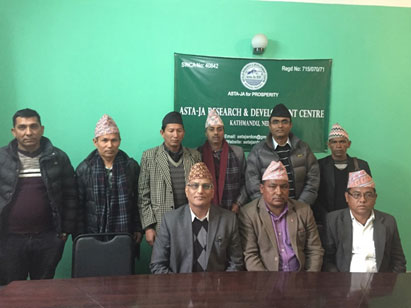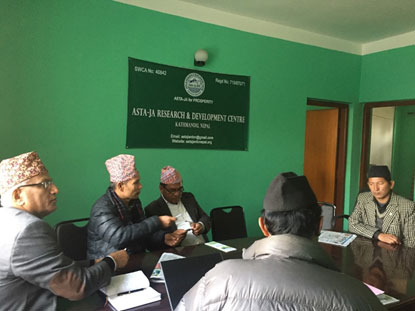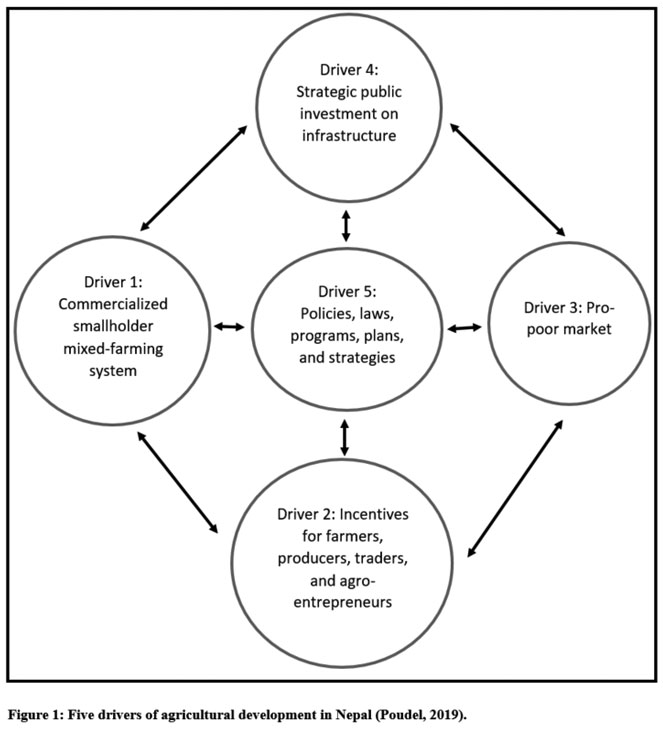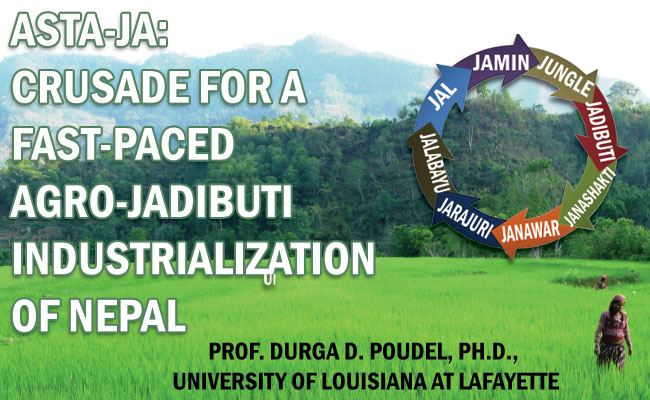Prof. Durga D. Poudel, Ph.D., University of Louisiana at Lafayette
As more than 1,750 youths are leaving the country daily for foreign employment, rural villages in Nepal are turning into lonely places with broken families, barren agricultural lands, and absence of youths. While about seven million Nepalese reportedly are working in foreign countries, about 6,000 migrant workers have lost their lives in past nine years in foreign lands, imports of agricultural commodities and food items is increasing at alarming rate every year in Nepal. Dust pollution in the cities have reached to a point that rains have started falling as slurries of dusts and people have to drive away from the cities to get full breath of clean air. Food contamination and toxicity, poor quality of drinking water, soil pollution, deforestation, deteriorating law and order, sub-standard hospital facilities, unaffordable education, poor academic standards, and adverse climate change impacts are escalating further degradation of Nepalese society. In order to effectively address these challenges and drive the nation in the fast-paced path of socio-economic transformation, there is no alternative to a massive grassroots-based agro-Jadibuti industrialization of the country through sustainable utilization of nation’s vast natural resources.

About a decade ago, I published a pioneering research article founding on Asta-Ja Framework [Asta-Ja meaning eight Ja, Nepali letter Ja (Jal (water), Jamin (land), Jungle (forest), Jadibuti (medicinal and aromatic plants), Janashakti (manpower), Janawar (animals), Jarajuri (crop plants), and Jalabau (climate))] in the Journal of Comparative International Management (11(1):15-27 and argued that Asta-Ja resources have greatest competitive advantages for socio-economic transformation of Nepal (Poudel, 2008). The letter Ja is also the eighth letter of Nepali alphabet in Devnagari script.
This ground-breaking publication was followed by subsequent research articles on Asta-Ja Framework, which included the Asta-Ja environmental and natural resources policy framework (Poudel, 2009), strategic framework (Poudel, 2011), and Asta-Ja management capacity-building framework (Poudel, 2012). The Asta-Ja Framework has been implemented for a decade in Nepal and has been successful in gaining attention of a broad-spectrum of stakeholders engaged in sustainable environmental and natural resources conservation and development and socio-economic transformation of the nation (Duquesne, 2011, 2013; Poudel, 2012a, 2014; Bhattarai, 2017).
This author is the Founding President of Asta-Ja Research and Development Center (Asta-Ja RDC, www.astajardcnepl.org), Kathmandu, Nepal, Founding member of Asta-Ja Abhiyan Nepal; International Coordinator of Asta-Ja International Coordination Council (Asta-Ja ICC) which has nearly 120 members representing 17 countires, member of Asta-Ja Agricultural Cooperative, Kathmandu, Nepal, and the Founding President of recently established US-based non-profit organization, Asta-Ja USA (www.astausa.org). During the past 10 years, Asta-Ja movement has made remarkable accomplishments in public outreach, organizational expansion, policy advocacy, community capacity-building, research and development, and disaster relief and recovery works. In this process, a vigorous outreach strategy was adapted in terms of reaching out the high level government officials, political leaders, intellectuals, media persons, expatriates, farmers, and other stakeholders (Poudel, 2012). Accordingly, several Asta-Ja interaction events were hosted which were presided by very high level government officials including sitting Prime Minister, Ministers, Vice Chairmen of National Planning Commission, Chief Secretaries, Secretaries of various Ministries, CEO of the bank, Political Leaders, Governor of Nepal Rastra Bank, and other stakeholders. These events were very well attended and the media coverages through TVs, newspapers, radio, and social media were remarkable. Another approach to reaching out high level individuals in the country included visiting their offices or residences by Asta-Ja team with a potted chilly (Akbare Khursani i.e. very hot chilly plant) or a flower plant, and introducing Asta-Ja concept to them, requesting them to water the plant, and then handing over the potted plants to the dignitaries by clapping hands. In this regard, Asta-Ja team visited very high profile individuals including the President of Nepal, King Gyanendra, several ex-Prime Ministers, Chief of Army Staff, Inspector General of Police, Chairmen/Presidents of major political parties in the nation, senior political leaders, media owners, and other stakeholders. All the dignitaries were very supportive and had expressed their solidarities to Asta-Ja campaign (Poudel, 2012).
In addition, thousands of leaflets on Asta-Ja were distributed to the attendees of various political conventions and meetings. In other occasions, individuals interested in Asta-Ja concept were invited to the Asta-Ja headquarters and were welcomed with Asta-Ja promotional items such as Asta-Ja scarf and brochures. Formation of district/local committees in about 30 districts of Nepal (Bhattarai, 2017), successful membership drives, and developing networks of commercial agricultural producers were additional accomplishments.
Activities related to policy advocacy included organizing high policy discussion events, visiting policy maker’s office by Asta-Ja team, hosting leader farmer policy advocacy interaction events, and doing popular writings (Poudel, 2012).
Specific policy agendas for advocacy included interest rate reduction for farmers, introduction of crop and livestock insurance policy, inclusion of Asta-Ja in the Constitution of Nepal, and the development of high school curriculum on Asta-Ja resources (Poudel, 2012). Social media and websites were also utilized for policy advocacy.
As a result, at least two policy successes were realized:
- Reduction of interest rate on livestock loans from 12% to 6% by Agriculture Development Bank, Ltd, and
- The introduction of Crop and Livestock Insurance Directives, 2013, by the Government of Nepal.
Community capacity-building activities included organizing field days and public meetings, conducting trainings, and introducing sustainable resources management technologies and practices to the local communities. Field days and public meetings were targeted to specific local communities. During these events, commercial agricultural producers and other stakeholders were invited to local farms where current issues and problems in relation to agricultural commodities and Jadibuti production and marketing were discussed. These meetings were of high interest especially for agricultural extension agents and commercial producers. Even the ambassador of Israel was often among the attendees (Poudel, 2012).
Various capacity-building training conducted included fruit and vegetable production, poultry production, goat production, and water quality monitoring. Asta-Ja RDC has received approval from CTEVT for running short training on Village Animal Health Worker, Off season vegetable production, and Community Agriculture Assistant.
Our disaster relief and recovery works related specifically to the devastating Gorkha earthquake on April 25, 2015. Asta-Ja Abhiyan Nepal immediately decided to get engaged on relief works and assisted an international medical team in setting up health camps in some of the affected areas, and, later, providing services through a Health Post for a couple of months in Lalitpur, Nepal. Asta-Ja RDC received funding support from various charity and non-profit community organizations abroad for hermetic (air tight) grain storage bags and rice and vegetable seeds and, in collaboration with the Ministry of Agriculture, Government of Nepal, distributed 40,000 hermetic bags to 23 districts and seed packages to over 600 families nearby Kathmandu Valley. Asta-Ja RDC also distributed Jasta Pata (galvanized iron sheet, roofing material) and blankets to earthquake victims. In addition, a rebuilding document was prepared within a month soliciting concept papers from Asta-Ja members, which was distributed to planning authorities and governmental offices in Kathmandu as well as uploaded on Asta-Ja RDC website (Asta-Ja ICC, 2015).
In 2018, Asta-Ja RDC successfully completed a project which was a cooperative agreement between Asta-Ja RDC and the United Nations Children’s Fund (UNICEF) for the implementation of a project entitled “Rebuilding Nutritional Security of Golden 1000 Days Earthquake hit Families”. This was an interdisciplinary Dry Chain project in a village in Kavre district. The overall objective of the project was to contribute to the reduction of malnutrition among 2015 Gorkha Earthquake affected children and mothers by using simple and scientific food storage Dry Chain technology. Thus, the first decade of its implementation in Nepal characterized with a vigorous community outreach, strong membership drive, sound policy advocacy, heavy engagement of high level government officials and dignitaries, community capacity-building, disaster relief works, and cutting-edge research and development.
Considering the urgent national need of employment generation, accelerated economic growth, and socio-economic transformation, Asta-Ja movement is now focusing heavily on rapid agro-Jadibuti industrialization of the nation. Asta-Ja will continue to serve as a common platform working in close coordination with governmental agencies, businesses, finance institutions, private industries, academic institutions, research and development institutions, and other stakeholders for information sharing, policy dialogues, research and development, investment generation, technology transfer, capacity-building, and other activities that are necessary for rapid agro-Jadibuti industrialization of the country. We encourage all Asta-Ja Campaigners living within and outside the country to pick up their respective communities in Nepal and start dialoguing with stakeholders in relation to the opportunities and challenges of developing agro-Jadibuti industries and business in their respective localities.

Privatization of more than three dozen agro-industries in the name of structural adjustment in 1990s was apparently a deadly move in relation to employment, agricultural advancement, and economic growth of the country. Various agro-industries affected by privatization include sugar factories, cotton industries, cigarette factories, jute mills, banaspati ghiu, rubber industry, tea companies, paper factory, leather industry, and others. In order to revitalize Nepalese agriculture, generate employment, achieve food self-sufficiency, and accelerate economic growth, there is no alternative to developing agricultural industries. Agro-based cottage industries such as organic coffee, cheese, leather products, handcrafts, garments, carpets, bamboo works, pickles, honey, woolen products, spices, and dairy products can immediately generate employment and household incomes for rural families. Agricultural industries such as rice, corn, wheat, millet, sugar, floriculture, fruits and vegetable, dairy, poultry, livestock, fish, spices and condiments; food manufacturing; and, different agricultural inputs and business along with diverse Jadibuti industries which include various medicinal, cosmetic, household products, nutrition and dietetics, and organic pesticides are necessary for accelerated economic growth and demand immediate attention for their development. Some of the major medicinal and aromatic plants (Jadibuti) found in Nepal include Aconitum heterophyllum (Atis), Aconitum spicatum (Bish), Bergenia spp. (Pakhanbed), Dioscorea deltoidea (Bhyakur), Epimerantha macraei(Jiwanti), Morchella spp. (Gucchi chyau), Nardostachys grandiflora (Jatamansi), Neopicrorhiza scrophulariiflora (Kutki), Rheum australe (Padamchal Amalbed), Silajeet (Olsen and Larsen, 2003), Cordyceps sinensis (Yarsagumba) (Devkota, 2006), Dactylorhiza hatagirea (Panchaule), and prickly ash (Timur). Other medicinal and aromatic plants commonly found in Nepal include swertia (Chiraito), Malabar nut (Asuro), jimbu, rudrachhe, cardamom, Ocimum sanctum (Tulsi), rauvolfia root (sarpagandga), Picrocarpus santalinus Linn (Ractachandan), Taxus baccata (Lothsalla), tejpat (Indian bay leaf), Butea frondasa (Amala), and Acacia catechu (Khair) (Poudel, 2008). They possess very high commercial value. Certainly, many more medicinal and aromatic plants are yet to be identified and recorded.

Smallholder mixed-farming system, which is practiced by nearly four million households in the country, is the backbone of Nepalese agriculture. Smallholder mixed-farming system is the “nucleus” of Nepalese agriculture. This system of farming evolved from thousands of years of cultivation of hill slopes, valleys, and flat lands in a small scale by individual families primarily to meet their household needs of food supply (Poudel, 2015). Smallholder family farms are the soul and pride of rural communities in Nepal. A family farm in smallholder mixed-farming system produces almost everything needed for a family such as cereals, fruits and vegetables, medicinal and aromatic plants, spice crops, ornamental plants, fodder trees, religious plants and their products, livestock, poultry, and other farm products. The smallholder mixed-farming system requires an unprecedented amount of knowledge, skills, technical knowhow, commitment, passion and dedication on the part of farmers and local communities coupled with appropriate governmental policies and programs for its success.
Many medicinal and aromatic plants are integral part of the smallholder mixed-farming system in Nepal. In this sense, a Nepalese farmer is not just a producer of conventional agricultural crops and livestock but also he/she is a producer of medicinal and aromatic plants. Therefore, Nepalese researchers, educators, industrialists, and developers have challenges integrating their knowledge and skills, and their businesses and industrial activities in relation to both agricultural and Jadibuti products. There is a huge opportunity for Nepal in further integrating Jadibuti in agriculture production and developing agro-Jadibuti industries at the local, regional, and national levels for employment and economic growth. Smallholder mixed-farming system serves as the foundation for village-based agro-Jadibuti industrialization in Nepal.
I identified five key drivers of agricultural transformation in Nepal (Poudel, 2019) in which smallholder mixed-farming system constitute the starting point for agricultural development in the country (Figure 1). Some of the approaches to commercialize smallholder mixed-farming system include contract farming, integration of new crops, value chain approach, specialized crop production zones, off-season crop production, agricultural cooperatives, and the development of rural agro-Jadibuti industries. Diversified agro-ecoregions of Nepal present unique and favorable crop growing conditions throughout the year and, thus, allow the production of organic fruits and vegetables and other crops in a competitive basis in the country (Poudel, 2008). Appropriate incentives for individual farmers, traders, suppliers, retailers, and other agents engaged in agricultural production, marketing and distribution is necessary for agricultural development. Premium prices or price guarantee on organic products will promote organic agriculture. Financial rewards can be given to farmers planting medicinal and aromatic plants in their farms. Incentivized agro-tourism is another way of strengthening rural agro-Jadibuti industries. Tax relief and financial assistance can be provided to traders for selling green technologies and products such as bio-pesticides, bio-fertilizers, food storage bags, etc. While government has a key role to play in order to develop a market by providing necessary physical infrastructure and institutions that support private sector and market dynamics, accelerated growth on agribusiness (agro-processing, post-harvest operation, and marketing) can be realized by encouraging private investments. Policies and programs, rules and regulation, and trade and agreements play crucial role in agri-Jadibuti industrialization by promoting agricultural production, processing, manufacturing, and exports. Agro-Jadibuti industrialization policies and programs should be developed considering competitive advantage, inclusiveness, and available local resources.

Nepal is still facing a historic challenge of re-building following the devastating 7.8 Magnitude earthquake on April 25, 2015, and a second 7.3 Magnitude earthquake on May 12, 2015. With a death toll of almost 9,000 and total injuries of more than 19,000 by May 23, 2015, there was a complete loss of a total of more than half a million building structures in Kathmandu Valley and 15 districts across the nation and the destruction of over 500 temples. Since agriculture is the main occupation of rural communities, it is quite logical to give major emphasis on agroindustrialization for rural re-construction and development.
In conclusion, Nepal is currently facing multidimensional developmental challenges including not only the development of infrastructures such as road networks, irrigation system, hydroelectricity, hospital system, educational facilities, and industries, but also overcoming serious environmental and ecological challenges. Intensity of these challenges will further increase in the coming years.
In order to effectively address these challenges and drive the nation in the fast-paced path of socio-economic transformation, there is no alternative to a massive grassroots-based agro-Jadibuti industrialization utilizing Nepal’s precious Asta-Ja (i.e. Jal, Jamin, Jungle, Jadibuti, Janashakti, Janawar, Jarajuri, Jalabayu) resources. Asta-Ja in collaboration with all other stakeholders continue its crusade on fast-paced and sustainable agro-Jadibuti industrialization of Nepal.
N.B.: References will be provided upon request.
Read:

